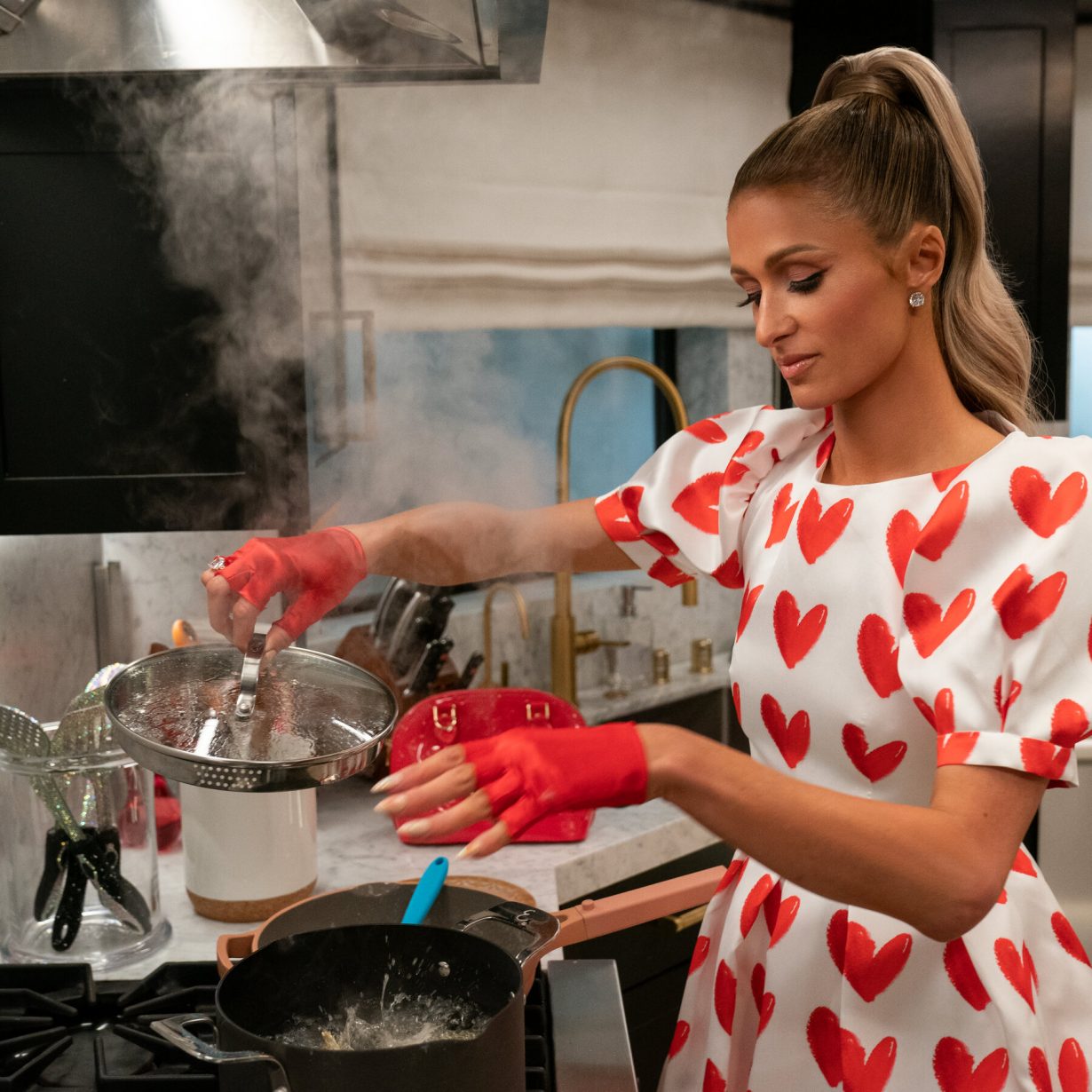What year is this? On her comeback Netflix show, Hilton offers a slavish recreation of her 2000s bimbo heiress persona
That the IMDB page for the production of Cooking with Paris has the TV series’ year of origin marked down as ‘2021,’ even if this is entirely accurate, feels like an error – certainly, it has a cameo from a version of Kim Kardashian with her current face, but otherwise its mood is pure 2007, as if an advertisement for TRL or Motorola Razr phones might interrupt at any second. The reason for this feeling of unsettling historic distance is its hostess Paris Hilton’s tireless commitment to what might be referred to as ‘the bit,’ the bit being the flawless execution of the character she first debuted on MTV’s The Simple Life in 2003. ‘Paris Hilton,’ a role played with such elegant seriousness that it is easy to believe the woman posing as her is an artist, is a brat, a baby-voiced and breathy ditz whose comprehension of the world outside her rarefied existence is at best extremely limited, and at worst curtailed by a mixture of disinterest and disdain. She is dedicated to the maintenance of an appearance and a lifestyle that are close enough to Barbie’s to suggest the possibility of a lawsuit from Mattel, as if the manufacturer had made a version of the doll that was a rich bitch rather than a firefighter or a mermaid.
Hilton does look better than she ever has before, her strong nose and Veronica Lake haircut conspiring, now that she is middle-aged, to make her look less cute than handsome, like a gorgeous Afghan Hound in a Swarovski-studded collar. Her bimbo heiress act has aged less well. Since the release of her documentary This Is Paris in 2020, in which she revealed her real, huskier voice and intimated that the character of Paris Hilton had been designed to allow her to separate herself from who she seemed to be in public, it has felt as though she might at any moment mount a comeback in which she could shift her image into something closer to actual satire – crueller, edgier, more self-lacerating now that we can see the space between the woman and the stereotype. Cooking with Paris, a new six-episode series made for Netflix, shows her bumbling through recipes wearing couture in her flashy, girlie kitchen, purring buzzwords and proclaiming ignorance about utensils. “I only write in rainbow,” she says sweetly, showing a recipe book written in bright gel pens. “I get bored if it’s in all black or red or blue.” It is a pity the show lacks the kind of bitchy colour that might make it interesting, allowing Hilton to become a bona fide comedienne like her former Simple Life co-star, the cool, deadpan Nicole Richie.

Her new catchphrase, now that “that’s hot” is passé, is “sliving,” a portmanteau of ‘living your best life’ and ‘slaying’ that I kept mistaking – in my cynicism – for a slightly more defeatist portmanteau of ‘living’ and ‘surviving.’ She wears “sliving gloves,” which are horribly impractical fingerless biker gloves in various shades and finishes, to do her cooking; she makes “blue sliving marshmallows,” and has “sliving” slogan mugs and “sliving”-branded champagne on her countertops. The stupidity of “sliving” is the key to understanding the essential flaw behind the show, which is that it is at once an entirely slavish recreation of her 2000s persona, and mysteriously limp, as if she were half-there and half mentally spending her new Netflix pay-check somewhere on Rodeo Drive. ‘Where Britney humped the air on stage and then delivered press conferences about her virginity and Beyoncé kept even the most mundane details about her personal life under lock and key,’ a 2013 Vice profile suggested, ‘Paris wore short dresses and partied all night, secreting absolutely zero fucks from her pores.’ This is true – it’s also true that Britney Spears grew up dirt-poor and that Beyoncé is a Black woman, leaving them both without the killer combination of white skin and generational wealth that Paris Hilton has enjoyed since birth. Why, given the ugliness of celebrity at her noughties peak, and given the fact that she has not once needed the cash, did she ever want to be a public figure in the first place?
The theory that she is approaching the character ‘Paris Hilton’ as if she is a performance artist rather than a socialite, which has been circulating since the 2010s and was more-or-less shored up by that documentary, makes it easier to codify Cooking with Paris as the equivalent of Marina Abramović’s late-career softball collaborations with, for instance, Lady Gaga – a commercially viable, lucrative comeback piece that helps to turn the artist into even more of an unchanging logo than before. “I created this brand and this persona and this character,” Hilton said in This Is Paris, “and I’ve been stuck with her ever since.” If she feels resentful of the hot-pink monkey on her back, she does not show it in the six episodes of Cooking with Paris. Perhaps for the present moment, she is looking for a simple life in lieu of a particularly new one. There is just one detail that makes it extremely clear that this is 2021, and that Paris may be looking for a different role to play: she admits to needing to expand her cooking repertoire because she “wants to be a mom.”
